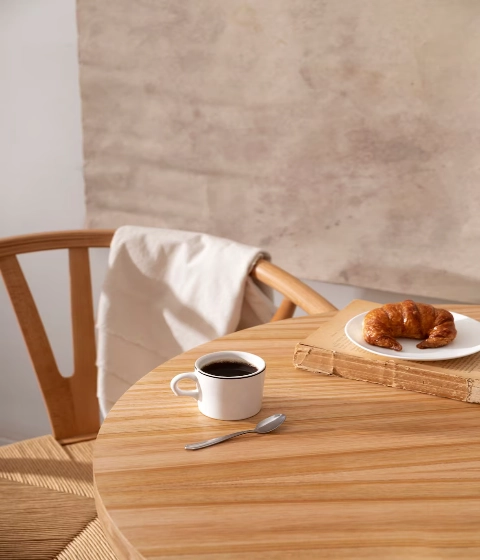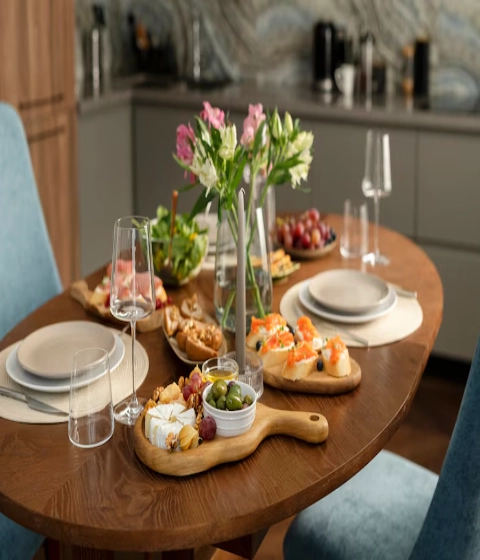How to Match Dining Table Dimensions with Room Proportions Effectively?

Picking the perfect dining table makes your space both useful and pretty. This guide covers key things to think about when choosing table sizes. It talks about how table shapes affect a room, important measurements, and design choices that fit your space. You’ll also learn why FOREST is a reliable supplier, helping you create a welcoming dining area that matches your style.
What Factors Should Be Considered When Choosing Dining Table Dimensions?
Choosing the right dining table means finding a balance between size, comfort, and room setup. This ensures the space works well and feels inviting.
The Importance of Room Size and Layout
The size and layout of your dining room are the starting point for picking table dimensions. Measure the room’s length and width. Note any doors, windows, or other furniture, like a buffet, that might take up space. In open-plan homes, you need to plan carefully. This keeps the dining area clear without blocking paths to other spaces. For example, placing the table near a kitchen in an open layout makes serving food easier. It also keeps walkways open.
Accounting for Seating Space and Comfort
Comfortable seating makes dining more enjoyable. Each person needs about 24 inches of width and 15 inches of depth for their plate and cutlery. This gives enough room for elbows and easy movement. For a table seating six, aim for at least 60 inches long. This fits three chairs on each side. Chairs are usually 17 to 19 inches high. They should match a standard table height of 28 to 30 inches for comfort. If you use armchairs, they might need up to 28 inches of width per seat. Planning for these measurements avoids cramped seating. It makes dining more pleasant.
How Does the Shape of a Dining Table Impact Room Proportions?
The shape of a dining table changes how it fits and feels in a room.
Exploring Different Table Shapes
Round tables (90-150cm diameter) foster intimacy, perfect for 4-6 person conversations with equal seating distance. Their curved edges maximize small square rooms. Rectangular tables (120-240cm length) accommodate 6-12 guests, ideal for elongated spaces but requiring generous floor area. Square tables (90-110cm sides) offer symmetry for 4-8 diners, complementing square layouts while avoiding narrow rooms. Oval designs blend circular sociability with rectangular capacity (120-240cm length), softening architectural lines while fitting diverse room sizes. Each shape creates distinct spatial dynamics – circular promotes interaction, rectangular facilitates serving, and oval combines both benefits. Consider traffic flow, wall proximity, and sightlines when selecting to harmonize proportions with your living space.
Matching Table Shape to Room Configuration
Picking a table shape that matches your room’s shape makes the space look unified. In a long, narrow room, a rectangular or oval table fits the room’s lines. It adds seats without taking over the space. Square or round tables work better in square rooms. They keep things even and make moving around easy.
Optimizing Space with Extendable Tables
Extendable tables are great for handling different group sizes. A 60-inch rectangular table with an 18-inch extra piece can stretch to 78 inches. This seats 6 to 8 people. Make sure the room can fit the longer table while keeping 36 to 48 inches of clear space around it. Round tables with extra pieces turn oval, adding seats without taking up much room. FOREST’s extendable dining tables are perfect for small spaces. They let you host bigger groups without losing everyday usefulness.
What Are the Key Measurements for Dining Tables in Various Room Sizes?
Exact measurements make sure your dining table fits well and works right. Clear spacing, balanced size ratios, and a nice look are important for a welcoming dining space.
Minimum Spacing Guidelines for Chairs and Walkways
Good spacing keeps things comfortable and easy to move around. Give each chair about 24 inches of width for elbow space. For six chairs, the table should be at least 60 inches long. Leave 36 to 48 inches between the table’s edge and walls or furniture. Near doors, keep 48 inches clear to avoid blocking paths. If you use a rug, it should stick out 24 to 30 inches past the table on all sides. This keeps chair legs on the rug when pulled out.
Proportional Ratios Between Table Size and Room Dimensions
The dining table should take up about one-third of the room’s length to look balanced. Don’t pick a table that leaves more than 6 feet of empty space to the wall. That can make the room feel off. Measure your room and subtract 6 to 8 feet for clearance. This gives you the biggest table size that works.
Balancing Functionality and Aesthetics
A table that’s the right size looks good and works well. A table too small for a big room seems out of place. One too big for a small space feels tight. Place the table under lights or near windows to use natural light, making it look better. In rooms used for more than dining, pick a table that works for eating, working, or crafts without taking over. FOREST’s versatile dining tables come in sizes and styles that balance usefulness and beauty.
|
Room Size |
Suggested Table Shape |
Table Size |
Seating Capacity |
|
10×10 ft |
Round/Square |
36–48 in |
4–6 people |
|
12×12 ft |
Round/Square/Rectangular |
48–60 in |
6–8 people |
|
12×16 ft |
Rectangular/Oval |
60–96 in |
6–12 people |
|
14×18 ft |
Rectangular/Oval |
72–120 in |
8–12 people |
How Can Material and Design Influence the Perception of Space?
The material and style of a dining table change how big or cozy a room feels. Colors, designs, and leg shapes help set the room’s mood and how spacious it seems.
The Role of Light and Dark Finishes in Room Appearance
Light colors, like light wood or white, bounce light around, making small rooms feel open and breezy. Dark colors, like deep brown or black, add warmth and class but can make a small space feel tighter. In big rooms, dark tables stand out without crowding the space. Glass or clear plastic tops make a room feel bigger by looking less heavy. Pick a color that works with your room’s light and size to get the feel you want.
Choosing Minimalist or Ornate Designs Based on Room Style
Simple tables with straight lines fit modern or small spaces. They keep things looking clean and uncluttered. Fancy tables with carved details or bold bases suit traditional or large rooms. They add personality without taking over. In a simple room, a plain table keeps things calm. In a classic room, a fancy table adds charm. FOREST’s custom dining tables offer both styles to match your room’s vibe.
The Effect of Table Leg Styles on Visual Space
The legs of a table affect how open a room looks. Thin, slanted legs or a single center base make the space feel light and open, great for small rooms. Thick legs or wide bases add weight, better for bigger spaces. For example, a round table with one base gives more legroom and opens up the floor, making the room seem bigger. Choose leg styles that balance sturdiness and openness to make your room look its best.
Why Is FOREST a Trusted Supplier for Dining Tables?
FOREST, a top furniture supplier from China, is known for making high-quality dining tables that mix style, strength, and usefulness for businesses worldwide.
Overview of FOREST’s Commitment to Quality Craftsmanship
FOREST uses top materials. Every table is checked carefully to ensure it’s built right and looks perfect. FOREST’s focus on quality makes them a dependable choice for stores and designers.
Customer Testimonials Highlighting Satisfaction with FOREST Products
Customers love FOREST’s quality and service. A store owner in Europe said, “FOREST’s dining tables are beautifully made and always arrive on time, helping us sell more.” A designer from the U.S. shared, “Their custom options let us create special pieces for our clients, who love the strength and style.” These comments show FOREST’s dedication to making customers happy with great products.

Conclusion
FOREST’s high-quality dining tables offer flexible options to make your space better. Build a dining area that shows your style and makes every meal special.
FAQs About Matching Dining Tables with Room Proportions
What is the ideal dining table size for a small room?
For a small room, like 10 by 10 feet, a round or square table 36 to 48 inches wide is best. It seats 4 to 6 people. Keep 36 inches of clear space around it for comfort and easy movement.
How much space should be left between the dining table and walls?
Leave at least 36 inches between the table’s edge and walls or furniture. Aim for 42 to 48 inches for easier walking. Near doors, keep 48 inches clear to avoid blocking paths.
Can I mix different chair styles with my dining table?
Yes, mixing chair styles adds charm, but make sure they share something, like color or material, to look cohesive.

